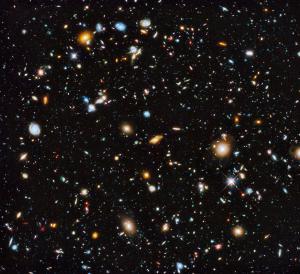Blog
Dark of Night
4 June 2014
When you look up in the night sky, there are areas of the sky that appear dark. That’s because there is nothing in that region bright enough for us to see with the naked eye. If you looked upon this region with a telescope, you would find dim stars and galaxies, but you would still see areas that appeared dark to you. How far could you take this? If you kept looking at smaller and smaller dark regions with ever more powerful telescopes, what would you see?
Starting in 2003, we’ve put this idea to the test when the Hubble telescope was aimed at one of the darkest patches of sky we could find, in the Fornax constellation. It is an area so small, it is the apparent size of a grain of sand held at arm’s length. Off and on over the next 9 years, the Hubble observed this region, gathering ever more light to see details in the image. Hubble gathered light at infrared and visible wavelengths, and most recently gathered ultraviolet wavelengths as well. After gathering light for about 1200 hours total, what you get is this:
 NASA, ESA, H. Teplitz and M. Rafelski (IPAC/Caltech), A. Koekemoer (STScI), R. Windhorst (Arizona State University), and Z. Levay (STScI)
NASA, ESA, H. Teplitz and M. Rafelski (IPAC/Caltech), A. Koekemoer (STScI), R. Windhorst (Arizona State University), and Z. Levay (STScI)There are about 10,000 galaxies in this image. 10,000 galaxies in the area of a sand grain. This is what lies within the dark of night.
From this image we’ve estimated that there are 100 billion galaxies in the visible universe. That’s more than 10 galaxies for every man, woman and child on Earth. Those galaxies might have an average of about 100 billion stars. Around most of those stars might be tens of planets. It is a vast sea in the dark of night.